钛硅分子筛的研究进展
钛硅分子筛的合成与应用

钛硅分子筛的合成与应用第一章:绪论1.1 研究背景和意义1.2 分子筛的概述及分类1.3 钛硅分子筛的起源和发展第二章:钛硅分子筛的合成方法2.1 溶胶-凝胶法合成2.2 直接合成法合成2.3 水热法合成2.4 离子交换法合成2.5 后处理方法第三章:钛硅分子筛的结构与性质3.1 结构特点3.2 物理化学性质3.3 热稳定性和酸碱性质3.4 表面性质第四章:钛硅分子筛在化学催化和环境净化中的应用4.1 催化剂4.2 吸附剂4.3 分离剂4.4 环境净化第五章:钛硅分子筛的发展趋势5.1 功能化钛硅分子筛的合成5.2 新型钛硅分子筛的研究5.3 应用前景结论参考文献第一章:绪论1.1 研究背景和意义材料科学领域的重要一环是高性能分子筛的设计、制备和应用。
其中钛硅分子筛是一种重要的催化剂、吸附剂和分离剂,其具有优异的热稳定性、化学稳定性和机械稳定性,能够在高温、高压、强酸和强碱环境下工作。
因此,研究钛硅分子筛的合成与应用具有重要的理论和应用价值。
1.2 分子筛的概述及分类分子筛是以大分子有机物为模板,在一定条件下合成的具有有序孔道结构的无机固体,其具有高度的孔隙度和优异的分子选择性。
分子筛可分类为无定形分子筛、低次元分子筛和高次元分子筛。
其中,高次元分子筛具有更加丰富的结构和性质,广泛应用于生产中。
1.3 钛硅分子筛的起源和发展1953年美国科学家W. H. Bradley首先合成了沸石分子筛,1964年,美国科学家L. B. Sand有机合成了高温有序多孔硅材料,步入高次元分子筛的研究大门。
20世纪60年代,钛硅分子筛的合成方法被研究出来。
在此基础上,研究者陆续发现了合适的合成方法和模板,得到了一系列重要的结构、性质和应用研究成果。
如今,钛硅分子筛已成为高次元分子筛领域的一个重要成员。
综上,研究钛硅分子筛的合成与应用,对推动高性能分子筛的发展、改善生产工艺、提高催化效率等具有十分重要的意义。
第二章:钛硅分子筛的合成方法钛硅分子筛的合成方法主要有四种:溶胶-凝胶法合成、直接合成法合成、水热法合成和离子交换法合成。
钛硅分子筛TS_1动态过滤的研究
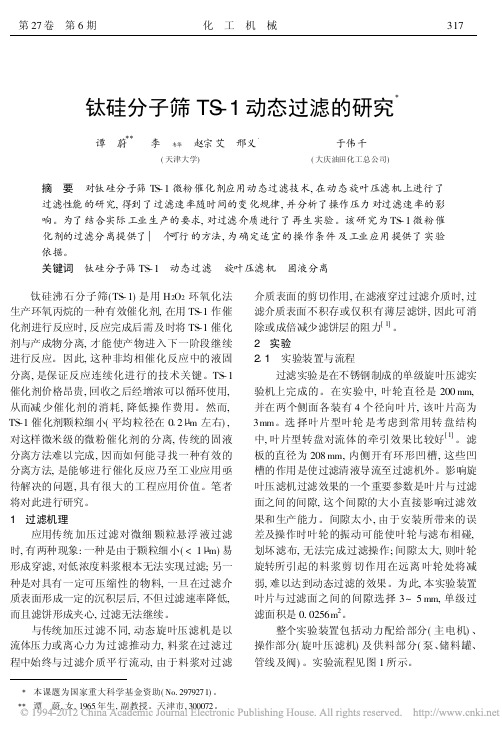
钛硅分子筛TS-1动态过滤的研究X谭蔚X X李韦华赵宗艾邢义(天津大学)于伟千(大庆油田化工总公司)摘要对钛硅分子筛TS-1微粉催化剂应用动态过滤技术,在动态旋叶压滤机上进行了过滤性能的研究,得到了过滤速率随时间的变化规律,并分析了操作压力对过滤速率的影响。
为了结合实际工业生产的要求,对过滤介质进行了再生实验。
该研究为TS-1微粉催化剂的过滤分离提供了一个可行的方法,为确定适宜的操作条件及工业应用提供了实验依据。
关键词钛硅分子筛TS-1动态过滤旋叶压滤机固液分离钛硅沸石分子筛(TS-1)是用H2O2环氧化法生产环氧丙烷的一种有效催化剂,在用TS-1作催化剂进行反应时,反应完成后需及时将TS-1催化剂与产成物分离,才能使产物进入下一阶段继续进行反应。
因此,这种非均相催化反应中的液固分离,是保证反应连续化进行的技术关键。
TS-1催化剂价格昂贵,回收之后经增浓可以循环使用,从而减少催化剂的消耗,降低操作费用。
然而, TS-1催化剂颗粒细小(平均粒径在012L m左右),对这样微米级的微粉催化剂的分离,传统的固液分离方法难以完成,因而如何能寻找一种有效的分离方法,是能够进行催化反应乃至工业应用亟待解决的问题,具有很大的工程应用价值。
笔者将对此进行研究。
1过滤机理应用传统加压过滤对微细颗粒悬浮液过滤时,有两种现象:一种是由于颗粒细小(<1L m)易形成穿滤,对低浓度料浆根本无法实现过滤;另一种是对具有一定可压缩性的物料,一旦在过滤介质表面形成一定的沉积层后,不但过滤速率降低,而且滤饼形成夹心,过滤无法继续。
与传统加压过滤不同,动态旋叶压滤机是以流体压力或离心力为过滤推动力,料浆在过滤过程中始终与过滤介质平行流动,由于料浆对过滤介质表面的剪切作用,在滤液穿过过滤介质时,过滤介质表面不积存或仅积有薄层滤饼,因此可消除或成倍减少滤饼层的阻力[1]。
2实验211实验装置与流程过滤实验是在不锈钢制成的单级旋叶压滤实验机上完成的。
钛硅分子筛TS_1的合成及催化性能研究

第11卷 第3期茂名学院学报Vol.11 No.32001年8月J OU RNAL OF MAOM IN G COLL EGEAug.2001钛硅分子筛TS -1的合成及催化性能研究王乐夫1,郭建维2,李雪辉3ΞΞΞΞΞΞ(1.茂名学院石油化工系,广东茂名 525000; 2.广东工业大学化学工程系,广东广州 510090;3.华南理工大学化学工程系,广东广州 510640)摘 要: 钛硅分子筛在环境友好工艺过程中发挥着越来越大的作用。
该文以TPAOH 为模板剂,TEOS 、硅溶胶、无定形氧化硅为硅源,合成了TS -1分子筛。
重点考察了合成条件对TS -1分子筛晶粒度的影响,并针对苯乙烯氧化反应体系分析了TS -1晶粒度对催化性能的影响。
关键词: TS -1;合成;晶粒度;催化性能中图分类号:TQ264 文献标识码:A 钛硅分子筛TS -1最早是1983年由Taramasso 等人〔1〕合成的,同其它类型的催化体系相比,采用TS -1分子筛作为催化剂进行氧化的体系具有如下优点:(1)反应条件温和,可在常压、低温(20~100℃)下进行;(2)氧化目的产物收率高,选择性好;(3)工艺过程简单;(4)可采用工业级H 2O 2(30%)为氧化剂,氧化剂安全易得,还原产物为H 2O ,没有对反应体系引入杂质,不会造成环境污染。
国外预言TS -1将成为二十一世纪绿色化学技术领域具有“原子经济”特征的新型催化剂。
早期采用经典的水热晶化法合成TS -1,分别采用TEOS 、TPAOH 和TEO T 为硅源、钛源、模板剂,其生产成本很高,操作条件极为苛刻,控制不当极易导致非骨架钛的生成。
近年来国内外研究集中在以下几个方面:(1)改进合成方法以简化操作条件;(2)寻找廉价合成原料,降低成本;(3)采用先进测试技术对TS -1的结构进行表征;(4)TS -1的新催化性能研究等方面。
在采用不同原料合成TS -1分子筛研究方面,可用的模板剂有TPAOH 、TPPOH 、TEAOH +TBAOH 、TPABr +N H3・H 2O 、HAD 等,但从催化效果来看TPAOH 模板剂显著优于其它类型,目前还没有TPAOH 模板剂的理想替代品。
钛硅分子筛催化合成酮肟的工艺研究
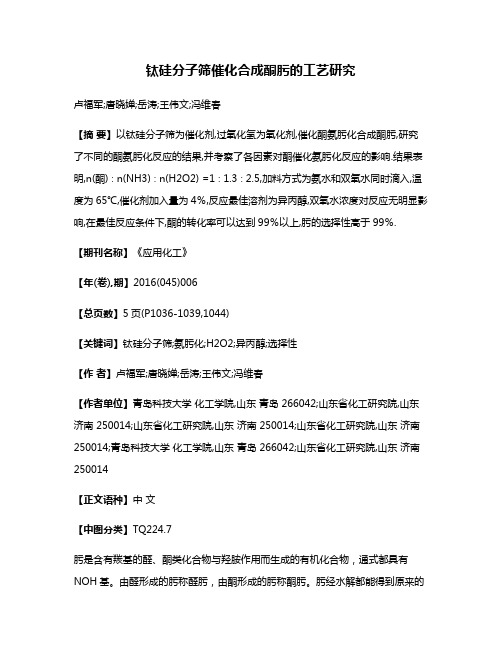
钛硅分子筛催化合成酮肟的工艺研究卢福军;唐晓婵;岳涛;王伟文;冯维春【摘要】以钛硅分子筛为催化剂,过氧化氢为氧化剂,催化酮氨肟化合成酮肟,研究了不同的酮氨肟化反应的结果,并考察了各因素对酮催化氨肟化反应的影响.结果表明,n(酮)∶n(NH3)∶n(H2O2) =1∶1.3∶2.5,加料方式为氨水和双氧水同时滴入,温度为65℃,催化剂加入量为4%,反应最佳溶剂为异丙醇,双氧水浓度对反应无明显影响,在最佳反应条件下,酮的转化率可以达到99%以上,肟的选择性高于99%.【期刊名称】《应用化工》【年(卷),期】2016(045)006【总页数】5页(P1036-1039,1044)【关键词】钛硅分子筛;氨肟化;H2O2;异丙醇;选择性【作者】卢福军;唐晓婵;岳涛;王伟文;冯维春【作者单位】青岛科技大学化工学院,山东青岛 266042;山东省化工研究院,山东济南 250014;山东省化工研究院,山东济南 250014;山东省化工研究院,山东济南250014;青岛科技大学化工学院,山东青岛 266042;山东省化工研究院,山东济南250014【正文语种】中文【中图分类】TQ224.7肟是含有羰基的醛、酮类化合物与羟胺作用而生成的有机化合物,通式都具有NOH基。
由醛形成的肟称醛肟,由酮形成的肟称酮肟。
肟经水解都能得到原来的醛或酮。
肟能发生重排反应而生成酰胺,工业上生产尼龙-6的原料己内酰胺[1]就是由环己酮生成的肟经重排反应得到的,苯乙酮肟重排形成乙酰苯胺。
肟也可以被钠汞齐或氢化还原生成胺。
有的肟还是重要的分析试剂,如丁二酮肟是分析化学中常用的定性和定量测定镍的试剂。
肟类化合物(主要是二甲基酮肟[2]、丁酮肟[3]、乙醛肟[4])作为新型除氧剂是美国Drew化学公司于1984年公开的专利,具有低毒、高效、速度快且具有钝化保护作用。
肟水解可以得到羟胺盐,而盐酸羟胺作为羟胺盐的重要产品,是重要的化工原料和有机合成中间体,是合成抗癌药羟基脲[5]、磺胺药新诺明[6]和农药灭多威[7]的原料。
钛硅分子筛的结构与物化特性研究进展
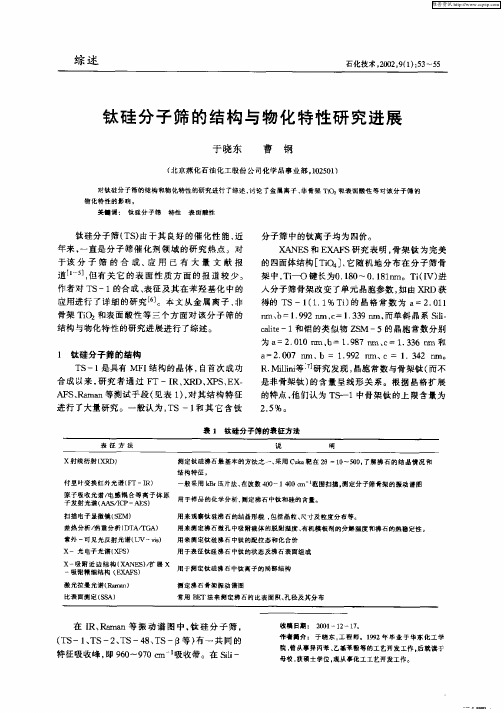
分子 筛 中的钛 离子 均为 四价 。
X E AN S和 E £ ) 研 究 表 明 , 架 钛 为完 美 骨
的四面体结构 [ i4 , 随机地 分布在分子筛骨 TO ]它 架 中 , —o 键长 为0 10 .8 n Ti .8 ~0 1 1m。TiI 进 (v)
扫 描 电子 显 微 镜 (E ) sM 差 热 分析 / 热重 分 析 ( T I D A/ GA) 紫外 一可 见 光 反 射 光 谱 ( uv— ) 3 x一 光 电子 光 谱 ( 玛) Ⅺ
用来观察钍硅沸石 的结晶形貌 , 包括晶粒、 尺寸厦粒度分 布等。 用来测定沸石徽孔 中吸附液体的脱 附温度 、 有机摸板剂的分解温度 和沸石的热稳定性。
维普资讯
综 述
石 技 2 0 ,( )5 -5 化 术 0 2 9 1 :3 5
,
钛 硅 分 子筛 的结构 与 物 化特 性 研 究 进 展
于晓东 曹 钢
( 北京燕化 石油化工股份公司化学品事 业部 。0 5 1 12 0 )
对 钍 硅 分 于 筛 的 鳍 构 和 物化 特性 的研 究 进 行 了综 述 , 论 了 金 属 离 子 、 骨 架 讨 非 物 化 特 性 的髟 响 美■词 : 钍硅分子啼 特性 表 面 酸性 和 表 面 酸 性 等 对 该 分 子 筛 的
特征 吸 收峰 . 9 0 9 0cn 吸 收带。在 Sl 即 6 - 7 r i一 l
收稿 日期 : 2 0 —1 —1 01 2 7 作者柚丹 : 于晓东 . 程师。19 工 92年毕韭 于华东 化工学 院. 曾从事异丙苯、 己基苯酚等的工艺开发工作 。 后就读于
母 授 . 硬 土 学 位 , 从 事 化 工 工 艺 开 发工 作 。 获 现
介孔-微钛硅孔分子筛MTS-9的催化性能研究

近 年 来 涌 现 出 的 T— C 4 、iS A一 5 T— S等 介 iM M- 1T— B 1 、iHM
孔 钛 硅 分 子 筛 , 大 分子 的催 化 氧 化 提 供 了很 好 的机 会 。 然 为
而. 当前 有 序 介 孔 钛 硅 材 料 的 催 化 氧 化 活 性 和 水 热 稳 定 性 与
应 用 技 术
詈
介 孔 一微 钛 硅 孔 分子 筛 MTS 9的催 化 性 能研 究 -
李 淼
・
, _ _ ・ I
一
鄹 肓
在 精 细 化 工 过 程 中 .例 如 绿 色催 化 氧 化
反 应 中 .传 统 的催 化 剂 为 一 分 子 筛 . 1
‘
_- ■0
基 苯 酚 7 m l催 化 剂 5 g和 25m .m o, 3 0m . L丙 酮 溶 剂 混 合 。当
很 大 的 不 同 表 明 在 T — M- 1 M S 9和 T 一 之 间 的 反 iMC 4 与 T 一 S1
们 所 追求 的
D o 等用 S X ( 角 度 X一 线 散 射 )研 究 了 MF eMo r A S 小 射 I 的形 成 过 程 , 发 现 在 成 核 之 前 溶 液 中 有 纳 米 簇 。Pn a aa 并 in vi
引起 了广 泛 的 关 注 但 由 于 在 大 分子ห้องสมุดไป่ตู้的催 化 氧 化 过 程 中 T — S
、
结 果 与 分 析
1 子 筛 作 用 甚 微 . 就 限 制 了 它 在 精 细 化 工 和 制 药 行 业 中 分 这
的应 用
1苯 乙 烯 的环 氧化 。不 同钛 硅 分 子 筛 的苯 乙烯 环 氧 化 的 .
多级孔TS-1分子筛的制备及其苯羟基化反应性能研究

太原理工大学硕士研究生学位论文多级孔TS-1分子筛的制备及其苯羟基化反应性能研究摘要钛硅分子筛TS-1,在温和的条件下,以双氧水为氧化剂,在众多的催化氧化中表现优良的性能,得到了研究者的普遍关注。
然而,TS-1是一种典型的微孔分子筛,其狭窄的孔道尺寸限制了反应底物的扩散,且积碳容易堵塞孔道造成催化剂的失活;另一方面,TS-1分子筛骨架钛含量低,四配位骨架钛是主要的活性中心,限制了其催化活性。
近些年来,因多级孔沸石分子筛兼具有微孔分子筛和介孔分子筛的优点,多孔材料领域的研究人员将研究重点放在多级孔沸石分子筛的制备上。
而目前文献中所报道的合成多级孔钛硅分子筛TS-1的方法一般都存在制备过程复杂,成本昂贵等问题,不利于其在工业上的应用发展。
苯酚与苯二酚生产工业目前所面临的最大问题就是如何能找到更清洁,更安全,更绿色的新工艺来取代传统的生产方法。
将苯直接羟基化,以双氧水为氧化剂,只需一步化学反应就可从原料得到最终产品,符合绿色化学的理念。
本文主要针对TS-1分子筛狭窄的孔径限制了反应底物分子扩散、接触活性钛位点的问题。
采用价格低廉的非离子表面活性剂曲拉通为介孔模板剂,水热合成方法制备了一系列多级孔TS-1沸石分子筛,并分别系统研究了曲拉通浓度和链长对于制备催化剂的影响,旨在提高催化剂的活性和稳定性。
以苯羟基化反应为探针实验,主要的研究内容和结论如下:(1)以环境友好、价格低廉的非离子表面活性剂TritonX-100为介孔I太原理工大学硕士研究生学位论文模板剂,以(NH4)2CO3为晶化调节剂,采用水热合成方法制备了介孔均一、晶粒尺寸均匀、含钛量高的高活性及高稳定性的多级孔富钛TS-1。
通过调节TritonX-100含量可以控制催化剂材料的表面积和孔隙体积。
以过氧化氢为氧化剂,去离子水为溶剂,研究了多级孔富钛TS-1在苯羟基化反应中的催化性能。
制备的TS-1分子筛结合了多级孔和高钛含量的特点,在苯羟基化反应中表现出较好的催化活性,苯酚的产率从约18%增加到约27.7%,且稳定性好,重复使用5次未发生失活现象。
钛硅分子筛催化剂的研究进展

Research progress of titanium silicalite catalys tZhangxiaoming Zhangzhaorong Soujiquan Lishuben(Lanzhou Institute of Chemical Physics fine petrochemical intermediates National Engineering Research Center, Lanzhou 730000)The role of titanium catalyst in the oxidation reaction of organic compounds is well known [1, 2]. Introduced in the molecular sieve framework due to the molecular sieve having a regular pore structure and large specific surface area characteristics, hetero atom, having an oxidation-reduction ability to preparenovel catalytic oxidation catalyst, has been more interesting subject in 1983 ENI [3] the T ar amasso its collaborators first successful synthesis of the titanium-containing zeolite catalyst of TS-1, a subsequent study found, Tammonia oxidation [7] S-1 with H2O2 aqueous solution as oxidant and the oxidation reaction of a series of organic compounds, such as olefin epoxidation [4], the aromatic hydrocarbon ring hydroxylation [5, 6], ketone, alkane oxidation[8, 9] and the alcohol oxidation [10] and so the process has a unique shape-selective catalytic function as compared with other types of catalytic systems, the system (1) the mild reaction conditions (atmospheric pressure, 0 - 100 ° C); (2) the unique function of the shape-selective catalytic oxidation; (3) environmental friendliness.TS-1 has been very limited because the aperture is only about 0. 55 nm, and its range of applications where the aerodynamic diameter is greater than 0.60 nm substrate molecules can not enter within its pores without reactivity. Orderovercome this limitation, the type of catalyst to get a wider range of applications, the majority of scientists have successfully synthesized T S-2 [11], Ti-Beta [12] and a series of large aperture zeolite catalysts.In recent years, with the development of the petroleum refining and fine petrochemical technology requires the use of some reorganization of the oil to be effective. M41S [13, 14], HMS [15] and MSU [16] series of mesoporous molecular sieves Tiheteroatom derivatives T i-MCM-41 [17], Ti-MCM-48 [18], Ti-HMS [19, 20] and of Ti-the MSU [16] emerged, the latter in the selective oxidation of organic compoundsshowed higher catalytic activity.This paper reviews the recent years, the progress made in terms of microporous and mesoporous titanium silicalite catalyst preparation, characterization, and catalytic reaction.T S-1 is first synthesized, and also so far been studied most, and more thoroughly of a class of titanium silicalite catalyst. T S-1 is a Silicalite-1 isomorphously substituted derivatives thereof, having the MFI structure. TS- work and the results achieved many comments have been reported [10, 21 - 24] here only a brief overview of the TS-1 preparation, characterization, and their corresponding catalytic reaction.The classical method of preparing a zeolite catalyst is a hydrothermal synthesis method in the the earliest patent literature, Tar amasso [3] reported two preparation T S-1 The method of one is tetraethyl orthosilicate (T EOS) and tetraethylammonium n-titanate (TEOT) as silica source and a titanium source, and tetrapropyl ammonium hydroxide (TPA OH) as templating agent;other is a silica sol as a silicon source, and to dissolve in H2O2 the titanate as titanium source TPAOH templating agent in addition to the hydrothermal synthesis method, the TS -1 can also be obtained by the method of secondary synthesis TiCl4 and dealumination of ZSM-5 for vapor phase reaction, to give with hydrothermal synthesis method is similar to the structure [25], but this method is easy to cause anatase. Huanxin et al [26] for the titanium source, TEOS as a silicon source, and succeeded in synthesizing a T S-1 to T iCl3 The same catalytic activity, with the same reported in the literature, and the process can be effectively prevented from generation of anatase In addition, Tuel and T aarit, continuous coverage positive ions with phosphorus [27], 1, 6 - hexamethylene diammonium ion (Di -TPA) [28], tetraethyl ammonium hydroxide (TEAOH) / T PAOH and T EAOH / tetrabutyl ammonium hydroxide (T BA OH) [29] as a template to prepare T S-1 process. described using different Preparation of Template T S-1 is likely the. Preparation of Titanium Silicalite reagent over Na +, K + and other alkali metal ions of the concentration should be sufficiently low, because the alkali metal ions will hinder the titanium atom in the molecular sieve framework embedded; another the one hand, to prevent the preparation process difficult to dissolve the anatase anatase formation will lead to subsequent reaction of H2O2 decomposition and reduce the catalytic activity in order to prevent the generation of anatase, the preparation process should be vigorously stirred, so that titanium source in the silicon source is highly fragmented., Thangaraj, [7] the slower rate of hydrolysis the of tetrabutylammonium positive titanate (TBOT) Alternate TEOT, with anhydrous isopropyl alcohol as a co-solvent, and achieved good effect.TS-1 zeolite catalyst unique shape-selective catalytic oxidation function, undoubtedly has a direct relationship with the skeleton of T i (Ⅳ) Therefore, the focus of such zeolite characterization is to determine the existence of T i (Ⅳ) in the molecular sieveits ligand environment. characterization of TS-1, except for routine characterization of X-ray diffraction (XRD), N2 adsorption / desorption method, Fourier transform infrared spectroscopy (FT-IR) 29Si magic anglespinning nuclear magnetic resonance spectroscopy(29Si-MAS-NMR), diffuse reflectance UV - visible spectrum (DR UVVis), X-ray photoelectron spectroscopy (XPS), extended X-ray absorption fine structure (EXAFS) and X-ray absorption near edge structure analysis (XANES) and other technologies exist in the form of tetrahedral coordination T i (Ⅳ) provided the basis forAccording to the naming of IUPAC [40], the aperture between 2 - 50 nm molecular sieves for mesoporous molecular sieves. 1990s, class zeolite inorganic materials separation, ion exchange and catalytic disciplines one of the hot to longchain surfactants as templating agent, have been successfully synthesized M41S [13, 14], HMS [15] and MSU [16] and a series of mesoporous molecular sieves. formation mechanism of the pore structure of mesoporous molecular sieve research has been reported[41 - 46] At the sametime, Ti [17 - 20], V [47], Zr [48], Mn [49] and Cr [50] with the redox ability of transition metal atoms into mesoporous molecular sieveskeleton structure, get a lot of new catalysts for the preparation of fine chemicals which T i atom isomorphous substitution in the hole titanium silicalite has important significance of theoretical research and industrial application value.The Gont ier and T uel [20] also Press T anev to method prepared Ti-HMS, and preparation process of various factors such as the proportion of T iO2 / SiO2, isopropanol, surface active agent chain length, characteristic of the titanium source and of Surf / SiO2 system. found that in the preparation process, when the two reagents is mixed for 15 min, the resulting product had with Hex ago nal various characteristics of most of Surf / SiO2 the best ratio of 0.3 increase this proportion of the aperture increases, but the specific surface area and adsorption capacity is greatly reduced.Reviewed above on the synthesis, characterization and catalytic oxidation properties of titanium silicalite and mesoporous molecular sieves prepared its heteroatom derivatives can be seen, the titanium silicalite as a new type of selective oxidation catalyst demandis very important to the increasing volume of the preparation of fine chemicals. especially in recent years, the success of a series of mesoporous molecular sieves synthesis and application, making the range of applications greatly broaden the field has attracted more and more attention of researchersbut we should also see that there are still many problems in the field, such as the titanium silicalite catalytic reaction mechanism, the formation mechanism of mesoporous molecular sieves and skeleton in the presence of T i (Ⅳ) way for further exploration of these issuesand research will become a research focus in the coming period.钛硅分子筛催化剂的研究进展张小明张兆荣索继栓李树本( 中国科学院兰州化学物理研究所精细石油化工中间体国家工程研究中心兰州730000) 含钛催化剂在有机化合物氧化反应中的作用是众所周知的[ 1, 2] . 由于分子筛具有规整的孔道结构和较大的比表面积等特点, 在分子筛骨架中引入具有氧化还原能力的杂原子, 以制备新型的催化氧化催化剂, 一直是人们比较感兴趣的课题. 1983 年ENI[ 3] 的T ar amasso 及其合作者首次成功地合成了含钛的分子筛催化剂TS-1. 随后的研究发现, T S-1 在以H2O2 水溶液为氧化剂的一系列有机化合物的氧化反应, 如烯烃的环氧化[ 4]、芳烃环的羟基化[ 5, 6] 、酮的氨氧化[ 7] 、烷烃的氧化[ 8, 9] 及醇的氧化[ 10] 等过程中有独特的择形催化功能. 同其他类型的催化体系相比较,该体系有( 1)反应条件温和( 常压, 0- 100℃);( 2) 独特的择形催化氧化功能;( 3)环境友好等优点。
钛硅分子筛TS1催化环己酮氨肟化过程分析

影响环己酮氨肟化反应的因素
反应温度
反应压力
提高反应温度有利于反应的进行,但过高 的温度会导致催化剂失活和副反应增加。
催化剂用量
提高反应压力有利于氨肟化反应的进行, 但过高的压力会增加设备成本和操作难度 。
在反应过程中,催化剂的活性可能会受到一些因素的影响,如反应温度 、压力、物料浓度等,需要进行更深入的研究,以优化反应条件和催化
剂的性能。
对于催化剂的再生和循环使用方面,仍需要进行更多的研究,以提高催 化剂的寿命和降低生产成本。
THANK YOU
催化剂可循环使用,降低了生产成本,同时避免了传统催化剂带来的环境污染问题 。
03
环己酮氨肟化反应原 理
环己酮氨肟化反应的化学方程式
• 环己酮与过量的氨在钛硅分子筛TS-1催化剂的作用下,发生氨肟化反应,生成环己酮肟。该反应的化学方程式可以表示为 :C6H10O + NH3 → C6H11NO。
环己酮氨肟化反应的机理
研究目的和方法
研究目的
本实验旨在探究TS-1催化剂在环己酮氨肟化反应中的催化性 能,分析其活性与结构之间的关系,为进一步优化催化剂性 能提供理论依据。
研究方法
本实验采用实验室制备的TS-1催化剂,通过XRD、SEM、 BET等方法对催化剂进行表征。同时,在固定床反应器中开 展环己酮氨肟化反应,通过GC、HPLC等方法对产物进行分 析,考察催化剂活性与结构之间的关系。
物料配比
适量的催化剂可以提高反应速率和选择性 ,但过量的催化剂会导致成本增加和副反 应增加。
钛硅分子筛的技术现状及国内专利分析
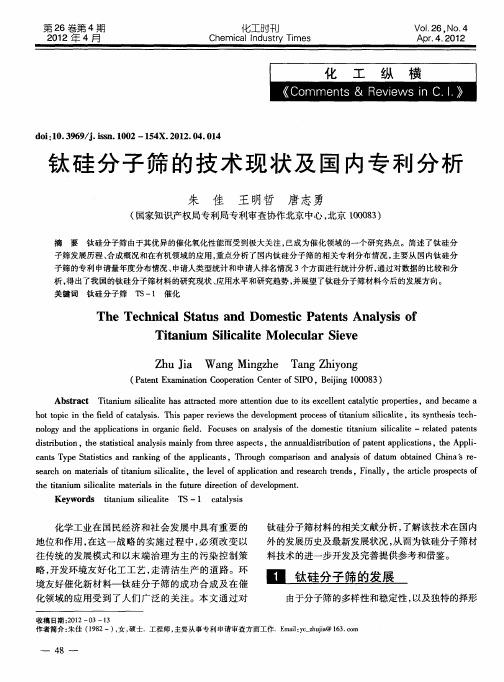
n l g n e a p ia in n o g n c f l . F c s s o n l sso e d me t tn u sl ai oo y a d t p l t s i ra i e d o u e n a ay i ft o s c t im i c l e—r lt d p tn s h c o i h i i a i t eae ae t d s i u in,te sait a n y i man y f m r e a p cs t e a n ad s iu i no a e t p l a in , h p i ir t t b o h tt il a a ss il r t e s e t , h n u it b t f tn p i t s t eAp l sc l o h l r o p a c o - c n sT p tt t s a d r n ig o e a p ia t .T r u h c mp r o n n y i fd t m o ti e h n ' r — a t y e S aii n a kn ft p l n s h o g o a s n a d a a s o au b n d C i as e sc h c i l s a s a c n mae a so tn u s ia i t e lv l fa p i ain a d r s ac e d , i al ,t e a t l r s e t f e r h o tr l f i i m i c l e, e e p l t n e e r h b n s F n l i ta l t h o c o y h r c e p o p cso i h i i m i c l e ma e l t u u e dr t n o v lp n . t e t n u sl ai tras i e f t r i c o f e eo me t a t i t i nh ei d Ke wo d t n u sl a i T y r s i i m i c l e a t i t s一1 c tl ss aay i
分子筛催化剂的研究进展

分子筛催化剂的研究进展一、本文概述分子筛催化剂,作为一种重要的多孔材料,因其独特的孔道结构和优异的催化性能,在石油化工、精细化工、环保和新能源等领域具有广泛的应用前景。
随着科学技术的不断进步,分子筛催化剂的研究和开发也日益受到人们的关注。
本文旨在综述近年来分子筛催化剂的研究进展,包括其合成方法、改性技术、催化性能优化以及应用领域的拓展等方面。
本文将介绍分子筛催化剂的基本概念和分类,阐述其孔道结构、酸性、表面性质等关键因素对催化性能的影响。
接着,重点回顾分子筛催化剂的合成方法,包括水热合成、溶剂热合成、离子交换法等,并分析不同合成方法对催化剂结构和性能的影响。
本文还将探讨分子筛催化剂的改性技术,如金属离子交换、表面修饰、复合改性等,旨在提高催化剂的活性、选择性和稳定性。
在催化性能优化方面,本文将分析催化剂活性位点的调控、反应条件的优化以及催化剂再生等方面的研究进展。
关注分子筛催化剂在石油化工、精细化工、环保和新能源等领域的应用实例,展示其在催化裂化、烷基化、酯化、氧化等反应中的优异性能。
本文将对分子筛催化剂的未来发展趋势进行展望,探讨新型分子筛催化剂的设计思路、合成方法以及应用领域拓展等方面的挑战与机遇。
通过本文的综述,旨在为相关领域的研究人员和企业提供有益的参考和借鉴,推动分子筛催化剂技术的不断创新和发展。
二、分子筛催化剂的基本原理分子筛催化剂,以其独特的孔道结构和高的比表面积,广泛应用于石油加工、精细化工以及环境保护等领域。
其基本原理主要源于分子筛的择形催化效应和酸性催化效应。
择形催化效应是分子筛催化剂最显著的特点之一。
由于分子筛具有规则的孔道结构和狭窄的孔径,只有尺寸小于孔径的分子才能进入孔道内部进行反应,而大于孔径的分子则被排斥在外。
这种效应使得分子筛催化剂在催化反应中表现出独特的选择性,能够实现某些特定化学反应的高效催化。
酸性催化效应是分子筛催化剂的另一重要原理。
分子筛表面的酸性位点能够催化多种酸碱反应,如裂化、异构化、烷基化等。
催化新材料
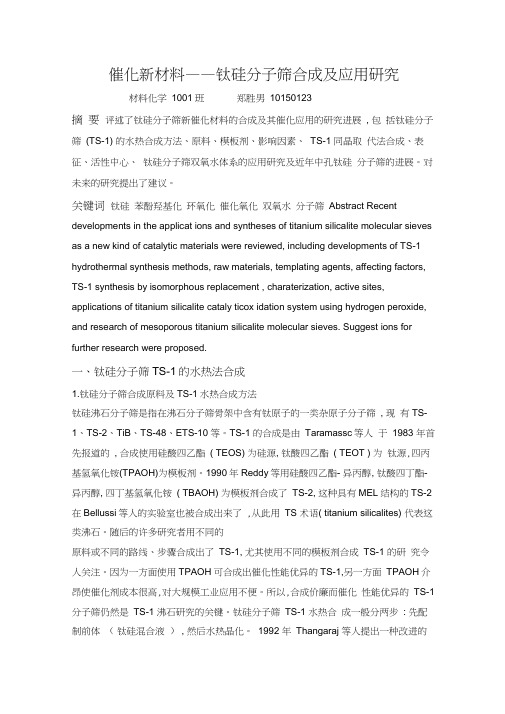
催化新材料——钛硅分子筛合成及应用研究材料化学1001班郑胜男10150123摘要评述了钛硅分子筛新催化材料的合成及其催化应用的研究进展, 包括钛硅分子筛(TS-1) 的水热合成方法、原料、模板剂、影响因素、TS-1 同晶取代法合成、表征、活性中心、钛硅分子筛双氧水体系的应用研究及近年中孔钛硅分子筛的进展。
对未来的研究提出了建议。
关键词钛硅苯酚羟基化环氧化催化氧化双氧水分子筛Abstract Recent developments in the applicat ions and syntheses of titanium silicalite molecular sieves as a new kind of catalytic materials were reviewed, including developments of TS-1 hydrothermal synthesis methods, raw materials, templating agents, affecting factors, TS-1 synthesis by isomorphous replacement , charaterization, active sites, applications of titanium silicalite cataly ticox idation system using hydrogen peroxide, and research of mesoporous titanium silicalite molecular sieves. Suggest ions for further research were proposed.一、钛硅分子筛TS-1的水热法合成1.钛硅分子筛合成原料及TS-1水热合成方法钛硅沸石分子筛是指在沸石分子筛骨架中含有钛原子的一类杂原子分子筛, 现有TS-1、TS-2、TiB、TS-48、ETS-10 等。
钛硅分子筛(TS-1)催化氧化二甲基硫醚制备二甲基砜的研究

钛硅分子筛(TS-1)催化氧化二甲基硫醚制备二甲基砜的研究李金凤;李会敏【摘要】以二甲基硫醚和双氧水为原料、钛硅分子筛为催化剂制备了二甲基砜,确定了最佳工艺条件,即常温下钛硅分子筛为二甲基硫醚质量的7%,二甲基硫醚与双氧水的摩尔比1砄1.05,反应时间1.5 h,二甲基硫醚转化率达99%以上,二甲基砜收率达98%以上。
%Dimethyl sulfone ( MSM) was prepared by oxidation dimethylsulfide ( DMS) with hydrogen peroxide over titanium silicate molecular sieve ( TS-1 ) and the preferable process conditions were determined.Under the conditions of ambient temperature and reaction for 1.5 h, TS-1:DMS(wt:wt)=7:93, and n(DMS):n(H2O2)=1:1.05, the conversion of DMS reached above 99%and the yield of MSM was above 98%.【期刊名称】《广州化工》【年(卷),期】2014(000)011【总页数】3页(P95-96,131)【关键词】二甲基砜;二甲基硫醚;钛硅分子筛( TS-1 );氧化【作者】李金凤;李会敏【作者单位】大唐克旗煤制天然气公司,内蒙古赤峰 025350;大唐克旗煤制天然气公司,内蒙古赤峰 025350【正文语种】中文【中图分类】TQ032.41二甲基砜是药物合成、染料中间体和食品添加剂的高温溶剂和高纯试剂、色谱固定液和分析试剂,作为一种有机硫化物,是人体胶原蛋白质合成的必须物质,作为保健品被应用,是维护人体生物硫元素平衡的主要药物[1]。
钛硅分子筛TS_1的合成和表征及其催化性能

文章编号:1005-4014(2003)04-0243-04 钛硅分子筛TS-1的合成和表征及其催化性能许绚丽1,安庆大1,翟 滨1,马淑杰2,裘式伦2(1.大连轻工业学院化学工程系,辽宁大连 116034;2.吉林大学化学系,吉林长春 130023)关键词:钛硅分子筛;水热合成;导向剂;羟基化摘要:采用导向剂法在水热体系中制得TS-1分子筛,合成过程中大大减少了T PAOH的用量,解决了钛硅分子筛T S-1合成成本昂贵的问题。
并采用X RD、F T-IR、U V-V is和SEM对所合成的分子筛进行了表征,还考察了所合成的分子筛催化苯酚羟基化的反应性能。
结果表明:采用导向剂法在适宜条件下可以合成出高结晶度的T S-1分子筛,产品为正交晶系,钛以四配位的形式存在于分子筛中;合成的TS-1分子筛具有良好的选择催化氧化性能。
中图分类号:O643.36 文献标识码:AS ynthesis and characterization of titanium silicalite TS-1zeoliteand its catalytic propertiesX U X uan-li1,AN Qing-da1,ZH AI Bin1,MA Shu-jie2,QIU Shi-lun2(1.Dept.of Chem.Eng.,Dalian I nst.of Lig ht Ind.,Dalian116034,China;2.Dept.of Chem.,Jilin Univ.,Changchun130023,China)Key words:titanium silicalite zeolite;hydrothermal synthesis;directing agent;hy droxylationA bstract:Titanium silicalite ZSM-5zeolite is synthesized with hydro thermal procedure by using the struc-ture directing agent.This method needs only a small amount of TPAOH(tetrapropylammonium hydrox-ide),and decreases the price fo r TS-1zeolite synthesis.XRD,IR,UV-vis,SEM and hydroxy lation of phe-nol were used to characterize the structure and catalytic properties of TS-1zeolite.It indicates that TS-1ze-olite synthesized by using the structure directing agent has high crystallinity.Ti4+entering into the frame-w ork of ZSM-5zeolite leads to superior cataly tic activity and selectivity fo r hydroxy lation of phenol. 钛硅分子筛TS-1(Ti-Si-ZSM-5)由于其优异的选择氧化催化性能及其催化的反应具有对环境污染轻,反应条件温和等优点而备受关注,钛硅分子筛的制备及应用研究是分子筛催化领域中的热点之一[1~3]。
混合硅源制备钛硅分子筛TS-1及其对噻吩的脱除研究
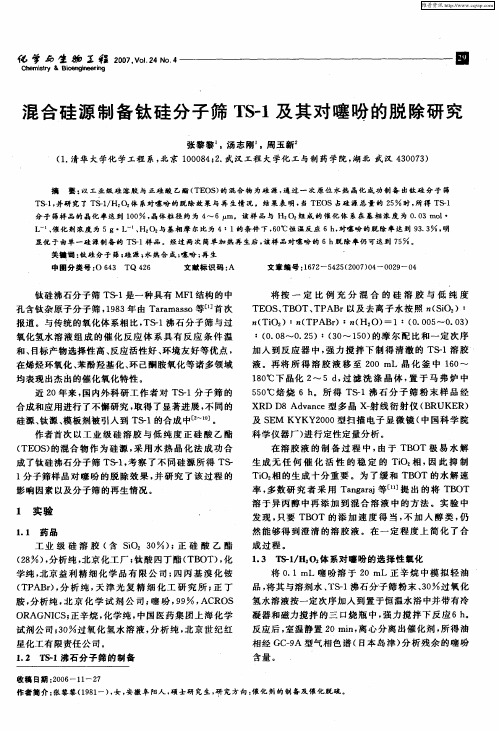
l3 -
1 H2 2 系对噻 吩 的选择 性 氧化 / 体 0
学纯 , 北京 益 利 精 细 化 学 品 有 限 公 司 ; 丙 基 溴 化 铵 四 ( P r , 析 纯 , 津 光 复 精 细 化 工 研 究 所 ; 丁 T AB ) 分 天 正 胺, 分析纯 , 京 化 学 试 剂 公 司 ; 盼 , 9 , ROS 北 噻 9 AC 0R AGNI S 正 辛烷 , C  ̄ 化学 纯 , 中国 医 药集 团 上 海 化学 试 剂公 司 ;O 过 氧化 氢 水 溶 液 , 析 纯 , 京 世 纪红 3 分 北 星化 工有 限责任 公 司 。
维普资讯
亿 与 生 物 = 程 20 。o2 o4 j : 07VJ 4 . . N
Ch mity & Bie gie r g e sr o n n ei n
圈
混合硅源制备钛硅分子筛 T 一 S1及其对噻吩的脱 除研究
张黎 黎 汤 志 刚 周 玉 新。 。 ,
生成 无 任 何 催 化 活 性 的 稳 定 的 T 0 相 , 此 抑 制 i 因
T O 相 的生 成 十分 重 。为 了缓 和 TB i 0T的 水解 速 率 , 数 研 究 者 采 用 T n a ̄ 等 L 多 a gr 1 出 的 将 T OT 提 B
1 实 验
1 1 药 品 .
溶 于异 丙 醇 中再 添 加 到 混 合 溶 液 中的 方 法 。实验 中
发现 , 要 TB 只 OT 的 添 加 速 度 得 当 , 加 入 醇 类 , 不 仍
然 能够 得 到 澄清 的溶 胶 液 。在 一 定 程 度 上 简 化 了 合
钛硅分子筛的结构与物化特性研究进展
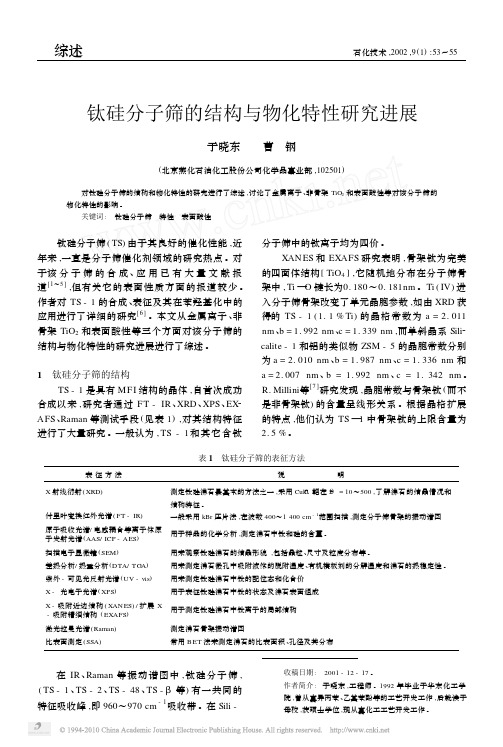
钛硅分子筛的结构与物化特性研究进展于晓东 曹 钢(北京燕化石油化工股份公司化学品事业部,102501) 对钛硅分子筛的结构和物化特性的研究进行了综述,讨论了金属离子、非骨架TiO 2和表面酸性等对该分子筛的物化特性的影响。
关键词: 钛硅分子筛 特性 表面酸性 收稿日期: 2001-12-17。
作者简介:于晓东,工程师。
1992年毕业于华东化工学院,曾从事异丙苯、乙基苯酚等的工艺开发工作,后就读于母校,获硕士学位,现从事化工工艺开发工作。
钛硅分子筛(TS )由于其良好的催化性能,近年来,一直是分子筛催化剂领域的研究热点。
对于该分子筛的合成、应用已有大量文献报道[1~5],但有关它的表面性质方面的报道较少。
作者对TS -1的合成、表征及其在苯羟基化中的应用进行了详细的研究[6]。
本文从金属离子、非骨架TiO 2和表面酸性等三个方面对该分子筛的结构与物化特性的研究进展进行了综述。
1 钛硅分子筛的结构TS -1是具有MFI 结构的晶体,自首次成功合成以来,研究者通过F T -IR 、XRD 、XPS 、EX 2AFS 、Raman 等测试手段(见表1),对其结构特征进行了大量研究。
一般认为,TS -1和其它含钛分子筛中的钛离子均为四价。
XAN ES 和EXAFS 研究表明,骨架钛为完美的四面体结构[TiO 4],它随机地分布在分子筛骨架中,Ti —O 键长为0.180~0.181nm 。
Ti (IV )进入分子筛骨架改变了单元晶胞参数,如由XRD 获得的TS -1(1.1%Ti )的晶格常数为a =2.011nm 、b =1.992nm 、c =1.339nm ,而单斜晶系Sili 2calite -1和铝的类似物ZSM -5的晶胞常数分别为a =2.010nm 、b =1.987nm 、c =1.336nm 和a =2.007nm 、b =1.992nm 、c =1.342nm 。
lini 等[7]研究发现,晶胞常数与骨架钛(而不是非骨架钛)的含量呈线形关系。
TS-1H2O2绿色催化体系研究现状

TS-1/H2O2绿色催化体系研究现状魏珍妮,黄鑫,张丽桦,南洋,刘肖飞(中国石油石油化工研究院兰州化工研究中心,甘肃兰州730060)摘要:钛硅分子筛是1种绿色友好的新型催化剂,广泛用于多种催化体系。
其中钛硅分子筛(TS-1)与过氧化氢(H2O2)组成的绿色催化氧化体系受到了较多科研工作者的关注,不仅仅是因为该体系具有反应条件温和、工艺流程短、产物选择性高等优势,该体系还能应用于烷烃氧化、烯烃氧化、酚羟基化、醇氧化及酮肟化等多个领域,且跟据现已完成的丙烯环氧化及环己酮氨肟化的工业化应用表明,该技术成本较低,很容易实现装置扩能、改造的需求。
由此看来,TS-1/H2O2催化体系符合当今化工行业的绿色友好的发展趋势。
关键词:钛硅分子筛;过氧化氢;绿色催化体系中图分类号:TQ426.94文献标识码:B文章编号:1671-4962(2022)01-0001-03Research status of TS-1/H2O2green catalytic systemWei Zhenni,Huang Xin,Zhang Lihua,Nan Yang,Liu Xiaofei(Lanzhou Petrochemical Research Center,PetroChina Petrochemical Research Institute,Lanzhou730060,China)Abstract:Titanium silicon molecular sieve is a new kind of green friendly catalyst,widely used in a variety of catalytic systems. Titanium silicon molecular sieve(TS-1)and hydrogen peroxide(H2O2)green catalytic oxidation system draw the attention of manyresearchers,not only because the system had advantages of mild reaction conditions,short technological process,high selectivity, but also because it can be applied for alkane oxidation,olefin oxidation,phenol hydroxylation,alcohol and ketone oxime oxide,and other fields.According to the industrial application of propylene epoxidation and cyclohexanone oxime,the cost of this technology was low,and it was easy to meet the needs of plant expansion and transformation.Therefore,TS-1/H2O2catalytic system was in line with the green and friendly development trend of the current chemical industry.Keywords:titanium silicon molecular sieve;hydrogen peroxide;green catalytic systemTS-1型钛硅分子筛是1种具有MFI拓扑结构的沸石类分子筛,其基本结构单元由硅氧4面体和钛氧4面体相互连接而形成的8个5元环构成。
1H→13C和1H→29SiCPMASNMR研究钛硅分子筛晶化
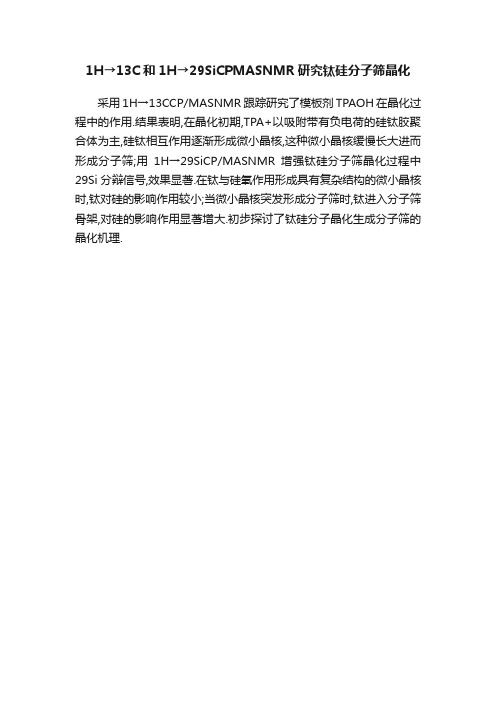
1H→13C和1H→29SiCPMASNMR研究钛硅分子筛晶化
采用1H→13CCP/MASNMR跟踪研究了模板剂TPAOH在晶化过程中的作用.结果表明,在晶化初期,TPA+以吸附带有负电荷的硅钛胶聚合体为主,硅钛相互作用逐渐形成微小晶核,这种微小晶核缓慢长大进而形成分子筛;用1H→29SiCP/MASNMR增强钛硅分子筛晶化过程中29Si分辩信号,效果显著.在钛与硅氧作用形成具有复杂结构的微小晶核时,钛对硅的影响作用较小;当微小晶核突发形成分子筛时,钛进入分子筛骨架,对硅的影响作用显著增大.初步探讨了钛硅分子晶化生成分子筛的晶化机理.。
钛硅分子筛TS—1合成及应用的研究进展
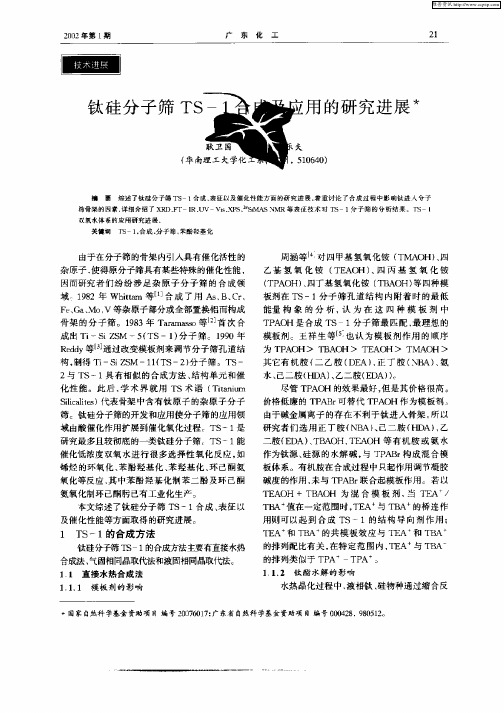
由于在 分子筛 的骨架 内引人具 有催化 活性 的
周涵 等 l对 四 甲基 氢氧 化 铵 ( MA 4 一 T OH)四 、 乙基 氢 氧 化 铵 ( A TE OH) 丙 基 氢 氧 化 铵 、四 ( A TP OH)四丁基 氢 氧化 铵 ( B OH) 四种模 、 TA 等 板剂 在 T S一1分 子 筛孔 道结 构 内 附 着 时 的最 低 能量 构 象 的 分 析 , 为 在 这 四 种 模 板 剂 中 认
行同晶取代 , 用 2 气吹扫, 再活化处理 , 制成 " I S 1 分子筛粉末。气固相 同晶取代时 , iI与分 TC 4 子筛缺陷( 羟基窝) i H 作用 , S —O 使钛进入骨架 结果 T 既取代了 s 也取代了 ~。骨架中较高 的 i i
杂原子 , 使得原分子筛具有某些特殊的催化性能, 因而研究 者们纷 纷涉足杂原子分子筛 的合成 领 域。18 92年 Wh t 等 合成 了用 A 、 、 r ia tm sB C 、 F 、 aMoV 等杂原 子部 分或 全部置换 铝 而构成 eG 、 、 骨架 的分 子筛。18 93年 T r a o等l 首次 合 aa s m s 2 J
TE OH + T AO 为 定范 围时 , E 与 TB 的桥连 作 A 值 T A A 用则 可 以 起 到 合 成 T S一1的结 构 导 向 剂作 用 ; T A E 和 TB A 的共 模 板 效 应 与 TE A 和 T A B
水、 己二胺 (ⅡA)乙二胺 (DA) }) 、 E ) 尽管 T A P OH 的效果 最好 , 但是 其价 格很 高 。
S i l s 代表骨架 中含有钛原子的杂原子 分子 i at ) l i c e 筛 钛硅分子筛的开发和应用使分子筛 的应用领
- 1、下载文档前请自行甄别文档内容的完整性,平台不提供额外的编辑、内容补充、找答案等附加服务。
- 2、"仅部分预览"的文档,不可在线预览部分如存在完整性等问题,可反馈申请退款(可完整预览的文档不适用该条件!)。
- 3、如文档侵犯您的权益,请联系客服反馈,我们会尽快为您处理(人工客服工作时间:9:00-18:30)。
Background and application of
the Titanosilicate Preparation and characterization of the Tianosilicate Structure and mechanism of the Tianosilicate
Cundy. C. S., et al., Chem. Rev., 103 (2003) 663
SEM of TS-1
Wilkenhoner.U., et al., J. Catal. 203 (2001) 201
IR spectra of TS-1
Pirutko.L. V., et al., Micropor Mesopor Mater 48 (1998) 345
Mechanism of structure direction and crystal growth in the synthesis of TS-1
Si
O O
O N+ OH
O Si O
Solution of Ti and Si
N+
OH
Ti O O
growing
growing
The growing of template simulated by computer
R R O
RR’CH2
By-product: only water !!!
RR’CHOH
O + NH3 NOH
R O R’
Already Industrialized (12,000t/a)
The route of preparing TS -1
Gas-solid isomorphous replacement
method
In-Situ embedded method
Hydrothermal method
Hydrothermal method
Si Source:
TEOS Fumed silica Colloidal silica Amorphous SiO2
Ti Source:
TEOT TPOT TBOT TiCl3 TiCl4 Amorphous TiO2
Background of TS-1
In1967,the zeolite containing TiⅣ was mentioned in US
3329480
In1983, the preparation and characterization of TS-1
was reported by Taramasso (Italy) in US 4410501
Keshavaraja. A.,et al.,J. Catal. 157 (1995) 501
Application of TS-1
OH OH OH
+
Already Industrialized (10,000t/a)
OH OH
OH
RR’CHOH
promising industrialized
TS-1 + 30 %H2O2
R
O H O HO Si H C
— ROH
Ti
O C
O Si
O Si
Notari. B., Adv. Catal. 41 (1996) 253
Mechanism 2 of TS-1
O
Ti H2O2
OH Ti
Remarkable shape-selectivity Friendly
The pore of TS-1 is about 0.5nm
Evaluation of TS-1
The selective oxidation of organic substrates by H2O2 in the presence of TS-1 is an interesting area of high potentiality for development of new environmentally friendly technologies
XRD of TS-1
The evident of the orthorhombic structure of TS-1
Bengoa. J. F.,et al., Micropor Mesopor Mater 24 (1998) 163
The Structure of MFI
Structure of TS-1
Notari. B., Adv. Catal. 41 (1996) 253
The advent of TS-1 represented the next major innovation enabling shape-selective oxidations to be carried out in industrial scale
Limtrakul. J.,et al., J. Mol. Catal., 207 (2004) 137
Surroundings of Ti
OSi SiO Ti OSi OSi
OH
Si O
O
Ti O
OH Si
Mechanism 1 of TS-1
OSi SiO Ti OSi OSi H2O2 Si O Si O O Si Ti OOH HO Si Si O Si O H2O2 OБайду номын сангаасSi Ti O C Si O Si O Ti OH HO Si O C C Si O Si O R O H O C HO Si H ROH (R=H, Me, Et)
Later , the preparation of Ti-ZSM-11, Ti-MCM-41 Ti-
HMS and Ti-MSU were reported.
Speciality of TS-1
Reacted under mild condition
(0℃-100℃, air pressure)
混合液 Template:
TPA+ TBP+/TEP+ TBA+/TEA+ TPA+/TEA+
Crystallized, filtrated,
washed, dried, calcined
TS-1
Mineralising agent:
OH- NH4+ Methylamine Hexanedimine
